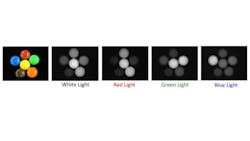How Have Lighting Solutions Evolved to Keep Pace with Advances in Machine Vision Camera Technology?
Editor's Note: On Vision is an ongoing series of opinion columns about issues and insights in machine vision and imaging.
We’ve been in machine vision since you needed to stop your production line to flip your vision system's binary switch and see if it was on or off. The industry has come a long way since then, and while technology has progressed by leaps and bounds, many principles and trends have stayed consistent, especially in lighting. As we celebrate our 25th anniversary at CCS America, Inc. (Woburn, MA, USA), we look back on the machine vision lighting industry over the past quarter-century and describe where we think it is heading in the future.
Machine Vision Lighting in 2000
To talk about lighting at the turn of the century, we need to look at where machine vision was at the time. While it had been used in scientific research since the 70s, it wasn’t until the late 1980s and early 1990s that industrial manufacturing adopted it.
However, broad uptake in manufacturing was inhibited by inadequate image detail and computational limitations. Camera resolutions were much lower—it was a time when 640 x 480 pixels was considered a good camera. In this analog and hardware-driven environment, computational power was not strong or fast enough to perform more complex processing tasks. Thus, machine vision systems were limited to basic algorithms for edge detection, thresholding, and pattern recognition.
On the lighting side, the industry was transitioning to LED lighting. Before then, conventional lighting solutions were mainly halogen lighting and fibers, but they were extremely bulky and hot. LED light sources did not have these issues and offered more flexibility in design, so you could shape them in almost any way you wanted. Combined with its directivity characteristics, many different lighting effects became possible beyond simply flooding an area with light, as we could control how light is directed, focused, and distributed onto the target.
Despite the many benefits, early LED lights had limits in performance. The intensity was extremely weak compared with today’s lights. And while they did not get as hot as halogen, they could still overheat, which led to reduced light output and compromised LED lifespan. Heat management was and still is a crucial part of LED lighting design.
By 2000, most of the key form factors such as ring lights, back lights, bar lights, and coaxial lights had already been developed. The four major visible light wavelengths (red, green, blue, and white) were also on the market. The main issue was that most people in the machine vision industry did not understand the physics of light well enough to use it effectively. They only used red light in their systems because they didn't know how other wavelengths could enhance contrast. During this period, lighting manufacturers focused on understanding how light behaves and why, then shared their knowledge with the rest of the industry. And no matter how much lighting technology advances, these principles are still the foundation of producing a clear image.
The Impact of Digital Cameras and Faster Production Lines on Lighting Technology
To encourage the wider use of vision systems, the industry had to overcome the limitations and inefficiencies of early machine vision technology and automation. One of the most significant steps forward in its evolution was the introduction of digital cameras. Megapixel sensors captured far more detail than analog cameras, which made it possible to perform more complicated inspections.
Production lines also grew faster as processing power improved. And with digitalization came standardization. Instead of proprietary vision systems that had to convert data from each other, standardized communication protocols such as GenICam and USB were established, making vision systems easier to integrate and therefore use.
As more complex applications became possible, lighting manufacturers needed to get better at controlling the directivity and focus of light. In the mid-2000s, two more key form factors were released: dome and flat dome lights. By diffusing light in multiple directions, they produced uniform illumination, which solved many of the challenges of inspecting reflective parts such as hot spots and shadows.
As higher camera resolution and greater processing power led to faster production lines, more light was needed to produce a clear image. To meet rising demand, LED manufacturers developed LEDs that were brighter, faster, and more economical to produce, allowing machine vision lighting manufacturers to design more powerful light sources. On the other hand, lighting manufacturers also improved techniques like overdriving and strobing to precisely control the lights, so they could quickly flash them at over 100% intensity, at the exact moment necessary to produce the clearest image.
The mid-2000s also saw the emergence of LED lighting in the non-visible wavelength range of ultraviolet and near infrared, which transformed what was possible for us to "see". More recent advancements include LEDs that emit light in the short-wave infrared (SWIR) range from 1050 – 1650 nm. The emergence of multispectral and hyperspectral lighting now allows machine vision to capture various types of information about an object in exceptional detail.
The Future State of Machine Vision Lighting
With the COVID-19 pandemic forcing the explosive growth of automation, machine vision's importance has become even more apparent. And while market needs are evolving, in some ways the demands are the same as they were 25 years ago. The main challenge lighting manufacturers must meet is achieving even more intensity to match ever-increasing production line speed.
Two areas of focus will help the machine vision lighting industry reach this goal. First, LED manufacturers are investing in the development of brighter LEDs. For example, there is an increasing shift towards SMD (surface-mounted device) LEDs, which are brighter than bullet-type LEDs. Also known as through-hole LEDs, bullet types encase a single, low-watt die in a bullet-shaped housing and have a lower light output than SMD LEDs. SMD-type LEDs that use multiple dies, or chips, in a single package can significantly enhance total light output. This technology, which has been used in full-color RGB lights and tunable white LEDs, has a cumulative light intensity much stronger than that of a single-die LED because each die contributes its own light.
The second focus will be on lighting control. Higher intensity will demand higher pulse frequency. To achieve more rapid on/off light switching while maintaining precision, lighting control will need to minimize switching delays and optimize synchronization with cameras.
Advanced connectivity and communication will drive the development of more sophisticated, dynamic, automated systems. Twenty-five years from now, machine vision will be capable of even more than it is now, and it will do the job even better and faster.
About the Author

Kazuhiro Umeda
Kazuhiro Umeda is the executive vice president and CTO at CCS America, Inc. (Woburn, MA, USA). With his diverse experience in application engineering, R&D, and production engineering, he has contributed to enhancing lighting solutions throughout our global network.

Barbara Gagnon
Barbara Gagnon is the director of sales and marketing at CCS America, Inc. (Woburn, MA, USA). Gagnon started her career in selling fibers before transitioning to LED lighting. She now has over 17 years of experience and has established herself as a well-known figure in the machine vision industry.
...


